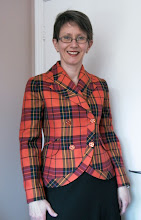And of course I also have another knitting project on the go too! Gotta get it all done before I go back to work (in two weeks, sniff).
I am making a shawl collared cardigan. I'd say it's my own design except that is not completely true. I'm way more comfortable starting with an existing base and modifying it than designing a garment from the ground up. In this case, I started with the schematic drawings for a cardigan of about the shape I wanted from a Bergère de France knitting catalogue (Créations 2014/15) that I bought a while back.
Incidentally, these publications are really great value. The
current catalogue is 288 pages and contains 144 patterns for garments and accessories for men, women and children, as well as toys, blanket and pillow type projects. Only $12 CAD, which is practically free in $US...
I really like the fact that every pattern has a really clear schematic drawing. I'm working from pattern #887. But I'm completely ignoring the fancy stitch pattern and the sideways-knitted collar piece.


How do I convert this to a machine knitting pattern? I'm sure there are high tech ways to do this but I haven't figured them out yet. (If you have suggestions, please by all means make them in the comments!) Here's my non-digital method.
First, knit a swatch in your chosen yarn. In this case I am using the same yarn (down to the dye lot#) as I used to knit my son's
zipper cardigan. So I already knew what stitch size to use on my Passap. If I was starting from scratch with a different yarn I would knit a big swatch of plain stockinette.
 |
| Telling me I have 18 stitches in 10cm |
Like this one, which is the swatch I used to determine the stitch size for the sleeves of my recently-completed red cardigan. I knit this using my worsted weight yarn on my mid-gauge machine (a Singer LK150). You cast on 50 stitches and knit segments of 40 rows in different stitch sizes. In the middle row, you attach a contrasting yarn tag on the needles that are 16th from the centre, on either side (making 30 stitches really obvious). Separate the sections with a couple of contrasting rows. Then take the knitting off the machine, block it (ideally wash it and let it dry) and then measure using the handy-dandy stitch gauge ruler that is appropriate for your machine. I found a really great explanation of this process on
Ravelry if you want to know more about measuring gauge.
 |
| My swatch |
You should also knit a swatch that includes details like your ribbing. Because I already knew my gauge, that's all I did for this project. I decided on 2x2 industrial ribbing because it's really springy and thick, and it looks identical on both sides.
Once you have decided on the density of fabric you like and you know your gauge of stitches and rows in 10cm, print off some
gauge-specific knitting graph paper. Make sure you print it without scaling! I like to use it at half size (so the "10cm" squares are actually 5cm on the page) because this is big enough to see the detail but not so big as to be unwieldy.
Then transfer the schematic to your paper. This is easy if you have an
engineer's or
architect's scale that is metric. Use the 1:20 edge if you have printed your graph paper at half size. An accurate metric ruler will also work but you'll have to do the mental math to get half scale. If you don't have the right kind of ruler, you'll have to use a calculator to figure out how many stitches or rows are needed for each segment of the schematic and count out the right number of tiny boxes on your graph paper - doable but a bit more painful.

Use a pencil or Frixion pen or some other erasable (very important!) writing implement.
At left is my graphed version of the Bergére de France schematic for the left front. The original information from the schematic are in orange Frixion pen and my changes (extending the front into a shawl collar) and key details are mostly in blue. I've taped two pages together to get the length I needed.
I've written key information on the chart - the dimensions of the finished piece, the ribbing pattern, the number of stitches I need, the row numbers in which changes like increases or decreases are made, precisely how many stitches are increased or decreased, etc.
I've also used the original pattern instructions to plot the shaping at the armhole edge. I could do this because the gauge for the pattern was very close to my actual gauge; if it hadn't been, I would have drawn a curve that looked about right and then charted the specific decreases. On the schematic the edge looks like a smooth curve; on my graph it is a steps and stairs effect; on the finished knitted piece it is again a smooth curve.

Speaking of the finished piece, I have now knitted both fronts (mentally mirror-imaging all the steps as I knit the right front) and I do believe my project is going to work!

 The photo at left is reasonably accurate in depicting the crazy colours in The Sewing Lawyer's recently completed jacket, and she likes all of them!
The photo at left is reasonably accurate in depicting the crazy colours in The Sewing Lawyer's recently completed jacket, and she likes all of them!



















